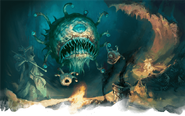Gazers (also known as eyeballs) were tiny, unintelligent beholderkin, who followed their creator like an aggressive pet, a fact that beholders considered amusing.[1] They often served as familiars for evil spellcasters serving under beholders.[1][4]
Description[]
Gazers resembled the beholder who had dreamed them into being with only minor differences. They possessed only four eyestalks rather than ten, and were only 8 inches (20 centimeters) across.[1]
Behavior[]
Gazers would follow their creators around like aggressive puppies, stalking their lairs looking for vermin to kill. They were not violent towards each other and were capable of cooperation. They could not be tamed by other people and would violently fling people away who tried to touch them. They preyed on and bullied any creature weaker than them.[1]
Wild gazers, after losing or being driven off by their creators, were territorial nuisances who hunted for small game in their area. Larger creatures who entered their territory were pestered and bothered until they left, although they would flee if challenged.[1] On the rare occasion gazers worked together in a pack, they would team up against larger creatures, and become much more dangerous.[3]
Combat[]
The four eyestalks of gazers could cause effects similar to the spells cause fear, daze, mage hand, and ray of frost.[1][4] They lacked a central eye ability and could only fire two beams at once. When working in a pack, some would keep enemies distracted with daze rays, while others shot at targets with frost rays. Beholders were capable of seeing out of the creatures' eyes and would sometimes give them to spellcasters for their own nefarious purposes. Eyeballs working as familiars could have one of their rays converted into a spell ray, capable of delivering touch spells as rays. Gazers also had the ability to mimic any speech they heard, repeating it in a high pitched tone.[1]
Ecology[]
A gazer was "born" out of a beholder's feverish dreams, in which its perception of scale and perspective was warped by its delirium. They could also be created via a magical process by beholder mages (although the process could be mimicked by others).[3] A gazer's eye could be transplanted into a humanoid by a beholder surgeon. The process killed the gazer, in a sense. This was done to turn said creature into an ocular adept, the only divine casters of the Great Mother who weren't beholders themselves. Vestiges of the gazer's psyche had some influence on the receiver of this surgery.[5]
Wild gazers made use of their ray of frost to hunt.[3]
Society[]
Beholders found the antics of gazers amusing and would often keep them as pets. They might also create small holes within their lairs to make it easier for the gazers to move around.[4] They could also bond with spellcasters of other races but were very hard to magically control or tame. This was easier to do if the spellcaster was a bully, who made constant use of his powers in an oppressive matter.[1]
History[]
In the mid-to-late 14th century DR, several evil spellcasters—including the phaerimm, the beholder mages of Ooltul, and a number of evil wizards—devised similar methods at the same time for creating mutated gazers.[3]
Appendix[]
Gallery[]
Appearances[]
References[]
- ↑ 1.0 1.1 1.2 1.3 1.4 1.5 1.6 1.7 1.8 1.9 Mike Mearls, et al. (November 2016). Volo's Guide to Monsters. Edited by Jeremy Crawford, et al. (Wizards of the Coast), pp. 7, 126. ISBN 978-0786966011.
- ↑ Ed Greenwood (December 2012). “Eye on the Realms: The High Priest of Beholders”. In Steve Winter ed. Dragon #418 (Wizards of the Coast), p. 58.
- ↑ 3.0 3.1 3.2 3.3 3.4 3.5 3.6 3.7 James Wyatt, Rob Heinsoo (February 2001). Monster Compendium: Monsters of Faerûn. Edited by Duane Maxwell. (Wizards of the Coast), pp. 23–24. ISBN 0-7869-1832-2.
- ↑ 4.0 4.1 4.2 4.3 Darrin Drader, Thomas M. Reid, Sean K. Reynolds, Wil Upchurch (June 2006). Mysteries of the Moonsea. Edited by John Thompson, Gary Sarli. (Wizards of the Coast), p. 35. ISBN 978-0-7869-3915-2.
- ↑ Eric L. Boyd, Erik Mona (May 2002). Faiths and Pantheons. Edited by Gwendolyn F.M. Kestrel, et al. (Wizards of the Coast), p. 200. ISBN 0-7869-2759-3.
Connections[]
Beholderkin
Death kiss • Director • Eye of the deep • Gauth • Gazer • Gouger • Observer • Overseer • Spectator
Undead beholders
Beholder zombie • Bloodkiss beholder • Death tyrant • Doomsphere

